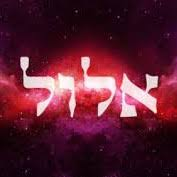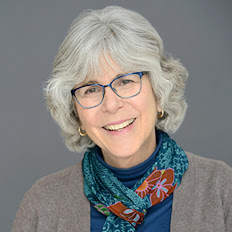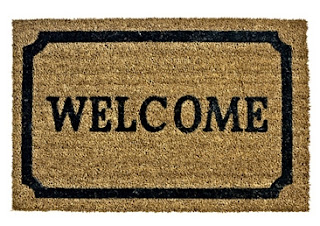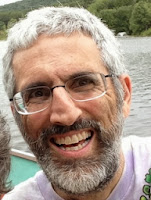by Jane F. Century
Thank you for the opportunity to mine
some of the many nuggets of wisdom that today’s parshat Pinchas has to offer us.
In the interests of full disclosure, I
need to preface my comments by saying that prior to this moment, I have given
exactly one d’var Torah in my entire life, at the start of last month’s
quarterly minyan meeting -- so I hope you will allow me some additional
latitude with this one. I also confess
I am something of a spiritual omnivore, so you may find me referencing things outside
the pale of the usual Jewish commentaries.
By way of additional background, I am
the middle child in a family with a sister one year older than me and a brother
three and half years younger than me.
We grew up in suburban Minneapolis,
where all three of us got bussed to after-school Hebrew school for five years
from 3rd grade to 7th grade, to a place that was very
broadly satirized by the Cohen brothers, who grew up there as well, in their
movie A Serious Man.
My family was firmly middle
class. After my parents undertook the
expense of celebrating a bat mitzvah and luncheon for my older sister when she
turned 13 and knowing that my brother’s bar mitzvah would be coming around the
bend in a few short years, my mother came to me privately when the time for my
own bat mitzvah was approaching and asked me if I really wanted one.
I didn’t need a flash card to know
what the right answer to that was.
If I agreed to take one for the team, my
mom promised they would throw me a lavish Sweet 16 party when the time came
instead.
I’m afraid you’ll have to wait for
another d’var to find out how that went.
Back to Pinchas, which brings together
four seemingly disparate stories with one common theme having to do with
legacy. For me, this parsha speaks to two profound concepts: the legacies we
hope to pass along to those who survive us, and the ways in which all of us
leave unfinished business in our wake.
The first example of legacy in this
parsha is the legacy granted by God to Pinchas, the grandson of Mose’s elder
brother Aaron, after he slays a high-ranking Israelite official and the
Midianite princess with whom he was publicly consorting.
Pinchas kills them both, and by this
act, he simultaneously atones for and halts a period of rampant idol worship
and the terrible plague that arose in the wake of it
In gratitude, God grants Pinchas a
covenant of peace, and the eternal covenant of kehunah for his zeal in
atoning for the children of Israel. In
doing so, he elevates Pinchas - along with all his descendants to the role of
priest.
Before that moment, only Aaron and his
descendants where designated by God as Kohanim. By blessing Pinchas in this way, God extends the
number of those who will inherit the honor and weight of a priestly connection
to the divine.
This is special legacy has continued
to be passed down through the millennia from fathers to sons to this very day,
indeed to this very room in which we sit.
The second legacy noted in this parsha
is the one that results when God commands Moses to undertake yet another census,
the aim of which will be to allocate future shares of the promised land in
perpetuity in proportion to the total number of men aged 20 and older in each
of their fathers’ tribes.
While
all this counting and divvying is taking place, the action moves to a third
story related to legacy in the parsha – one that marks something of radical
step for its time, in which the five orphaned daughters of Tzelophehad realize that in the wake of their father’s death, they
have no way to claim their own fair share of the inherited wealth that property
ownership would confer upon the men of their generation when they reach the
promised land.
At this time, women without brothers were excluded
from inheriting property when their father died, a system that continues in
many places in the world where women still struggle to be counted as equals. We
can also see its echoes in the racist practices of redlining that not only
denied certain categories of citizens the right to own their own homes but the
chance to build and pass on the wealth that such home ownership could generate for
their descendants.
At the time of Moses, women were effectively
prevented from inheriting their own family land, with all that implied for
their own financial autonomy and freedom to enter into marriage agreements.
These five brave women stood before Moses, Eleazer and the chieftains at the
Tent of Meeting, and basically asked to be counted.
Moses brought their case before God who
promptly agreed that Tzelophehad's daughters have “indeed spoken justly” and
instructed Moses that in future, “If a man dies and has no son, you shall
transfer his inheritance to his daughter.”
This brings us to the fourth and for
me the most powerful example of legacy in the parsha as the people draw close
to the Promised Land, in which God abruptly informs Moses he will not be
allowed to enter. The reason for this,
we learn earlier, is that after the death of Moses’ older sister Miriam and the
disappearance of Miriam’s well that had quenched the thirst of the Hebrew
people throughout their wanderings in the desert, God instructed Moses to
gather all the people crying out for water and bring forth water as he had done
once before, this time by speaking to the rock.
Instead, Moses grows angry at the people for their ingratitude and hits
the rock with his staff in frustration, unleashing not only water - but God’s
ire. Clearly, this was not the
demonstration of a faith that God had in mind, and he makes Moses take the fall
for it.
When we reflect on all that Moses
experienced in one lifetime, it is hard to fathom what emotions must have
passed through him on hearing that in one moment of anger he had forfeited his
long-sought dream of entering the land of milk and honey.
That after a life that began with
floating up to Pharoah’s daughter in a reed basket, being raised among royalty
only to flee for his life after killing an Egyptian soldier he saw beating an
enslaved fellow Jew, settling elsewhere to create a family for 40 years, speaking
to God via a burning bush that he needs to prepare for the Exodus from Egypt, after
repeated pleadings with Pharoah, after frogs, lice, vermin, etc, after the
parting of the Red Sea and getting to the other side, after reminding people
again and again that, unlike toilet paper, the supply chain of manna is
infinite, so there is no need to hoard it, after carrying down Tablets 1.0,
only to be greeted by the sight of a Golden Calf, and going back for Tablets
2.0, after beating back hordes of poisonous snakes with his own healing snake that
becomes a symbol of healing to this day, and after responding again and again
to the people’s seemingly endless doubts, misgivings and complaints, after all
of this ardor and tzuris, it seems hard to conceive that Moses himself would be
granted nothing more than a sneak peek from the top of Mount Abarim at the
legacy others would inherit by dint of all his efforts on their behalf.
Of all the people we meet in the
Torah, Moses has the most direct, intimate experience with the Divine Presence
across his long lifetime. He never serves as king. Although he is the youngest in his family, I
see him as the ultimate middle child between God and the people Israel and a skillful
cajoler of both. He is also a prophet, a teacher and a devoted leader - of followers
who do not always follow, who are mostly loyal, until they are not.
There are so many lessons to his
legacy, we can barely count them. And
yet after everything he had done, after running the final lap of a grueling
40-year marathon of Biblical proportions, Moses suddenly learns - not only will
he be prevented from crossing the finish line, but he won’t even live to set
foot on the other side of it. Instead,
he will soon be gathered up with his siblings in the world to come and buried
by God in an unmarked grave.
Moses later begs God in vain to give
him a second chance to experience the “good land on the other side of the
Jordan” when this same moment is recapitulated in Deuteronomy. But in this earlier
parsha, when he is confronted with the chilling finality of God’s words, to his
credit, he doesn’t hesitate. He immediately
opts to take one for the team. His heart
steps right up -- yet again -- to a place of compassion for his people, to urging
God to replace him in a timely fashion, lest the people wander about like sheep
without a shepherd. And it is Joshua who
will step into his shoes, rather than either of his own two sons.
Beyond the themes of legacy, this
parsha also speaks to two notions of time.
One is cyclical and the other linear.
The Jewish calendar binds us to countless cycles of recurring days and prayers
rejoicing in everything from waking up in the morning to vanquishing our
ancient enemies, days for grieving the loss of a loved one and for atoning for
the prior year’s transgressions. Days in which we savor the miracle of each
returning season of planting, flourishing and harvesting.
We reconnect with all these recurring
touchstones throughout the year like those cylindrical prayer wheels that hang
in Tibetan monasteries that the monks reach out and spin as they pass while
reciting their prayers. Around and
around we go through Rosh Hashana to Purim to Pesach to Shavuous and back.
But Mose’s life was a linear
story. For Moses, time stretched out
like a Torah scroll that would only be unrolled – and never wound back to the
beginning and repeated anew - except by all of us who inherited his legacy.
And tragically, for me at least, I
feel we are witnessing in this present moment a foreshadowing of an age of non-recurrence
that is unfolding before our very eyes, the legacy of humanity’s profound and
shameful degradation and dismantling of the living web of land, sea and sky,
which is already bringing an end to certain familiar cycles of migrations and
seasons that our planet has witnessed over eons.
In the face of obvious signs of glacial
melt and mass species extinction, we can no longer delude ourselves that the
natural cycles and rhythms of recurrence we once relied upon as children will
continue in our lifetimes.
And here is where I’d like to take a
big step sideways for a moment and take you on an imaginative journey by way of
the ancient book of divination, the I Ching, the Chinese Book of Change, that
some say dates back more than 5000 years, the source of which is said to be a
divine oracle. It is a book that
fascinated the psychotherapist Carl Jung throughout his life. It is intended to
be used as way of characterizing the essential nature of this very moment in
time in which the person consulting it finds themselves. Consulting the I Ching
can yield one or more of 64 possible responses or hexagrams. Each has a name. Interestingly Number 63 is called “After the
End,” but the very last chapter, Number 64 is called “Before the End.”
I was struck recently by how closely
the language of “Before the End” mirrors the literal and psychological moment
of Moses reaching Mount Abarim and resonates powerfully with how we understand
ourselves as we approach the completion of a long sought goal.
I ask your indulgence in letting me
read this passage and ask you to imagine Moses standing reading this to
himself:
BEFORE
THE END
“The
accomplishment of a goal is in sight. It appears that long-impending matters
may be brought to fruition with an acceptable amount of effort. Increasing
clarity surrounds the meaning of situations once thought to be obscure. At the
time of BEFORE THE END there is great promise for the future. A unique and sage
viewpoint is present in human affairs. Order can be brought to chaotic
situations.
“Because
you are now unusually familiar with the elements involved in the object of your
inquiry, you can evaluate and arrange them in whatever way necessary to achieve
your aim. It should be a relatively simple matter to bring together groups of
people in social or public-minded situations. By penetrating the psyche of each
individual involved, you can arrange to gratify their needs within the group
mechanism and thereby gain their co-operation.
“Yet,
it would be a mistake to imagine that by achieving your aim you will bring
matters to a close, that good judgment and order will prevail.
“The
time BEFORE THE END can be compared to a lengthy trek over a high mountain. At
some point, before reaching the peak, you can see in detail exactly how much
farther you must travel.
“You
will know what is involved in reaching the top because of your experience in
the climb so far. However, when you do reach the peak, which has been in your
sight for many long days of effort, you will have done only that.
“You
will have acquired little information and no experience whatsoever about
descending the other side. To rush up and over the top in an overly confident
manner could bring disaster.
“In
this passage The Book of Change warns at some length, of the dangers of
proceeding without caution immediately BEFORE THE END. You must prepare
yourself with wariness and reserve. The coming situation will be strange to you
in every way, unlike any that you have experienced. In the near future you will
not be able to draw upon the wealth of your acquired experience, for in many
ways the time will be nothing short of a rebirth. The idea of rebirth here is a
key to the meaning of the I Ching as a whole. The book ends with a new
beginning, cycling back to the first hexagram, CREATIVE POWER, forever and ever
into eternity.” [Source: The I Ching Workbook by R.L. Wing, December
19, 1979]
In this parsha, we stand as witnesses
with Moses as he reaches both the pinnacle of his life and its end, calling us
to imagine how we might feel if we stood in his shoes on Mount Abarim. The word
Abarim means “passage.” Is this moment a
tragedy or a passage to a new era?
Or as Mitch Albom, author of Tuesdays
with Morrie, might say “All endings are also beginnings. We just don't know
it at the time.”
My questions for you:
1. How do you yourself feel about the legacy of
Moses and the way his journey ends? Do
you see it as tragic, as appropriate, as a necessary evil or as creating space
for a rebirth?
2. How much of your own identity and life pursuit
is wrapped up in what you hope to leave behind as a legacy?
3. In what ways, if any, have you prepared
yourself for the massive changes in our environmental, political, and economic lives
that signal things may never cycle back in our lifetimes to where they were
before?











